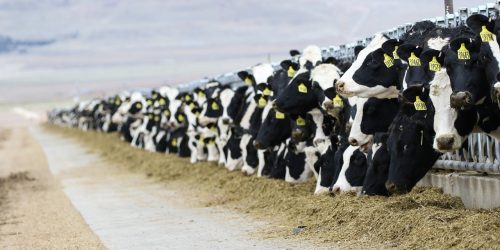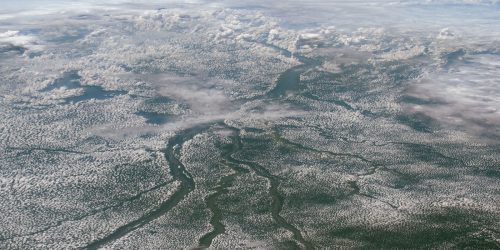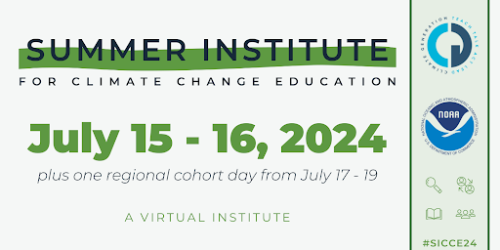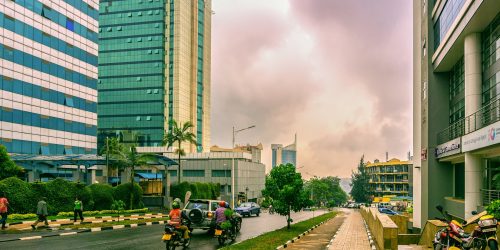CPO’s Atmospheric Chemistry, Carbon Cycle, and Climate (AC4) program is announcing 10 new 3-year projects and 1 new 2-year project in Fiscal Year 2021 that aim to increase our understanding of emissions and chemical transformation in the urban atmosphere. The competitively selected projects total $5.48M1 in grants.
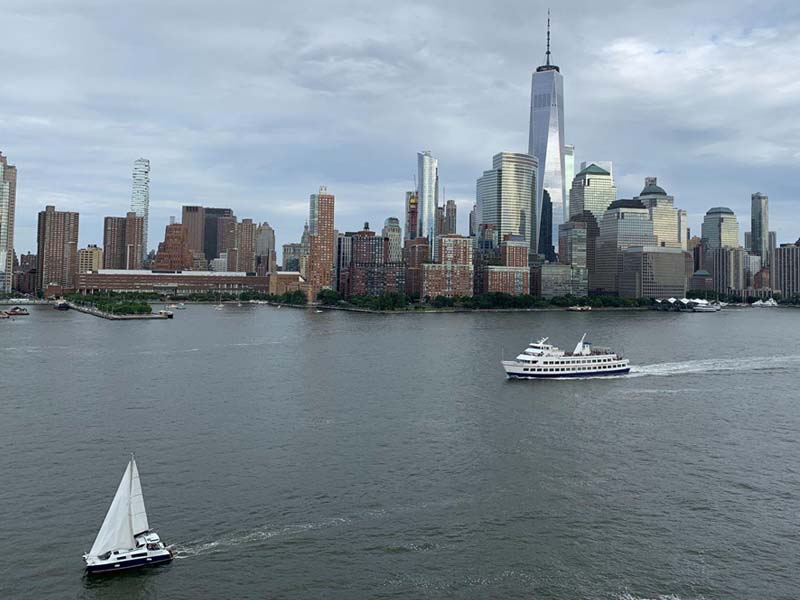
Despite decades of decline in ground-level ozone and fine particulate matter (PM2.5), many U.S. metropolitan areas still violate the 8-hour ozone standard as regulated under the Clean Air Act. This could be a result of unanticipated trends in emissions, increasing influence of regional background sources, long-range transport, changes in atmospheric chemistry, and/or a consequence of a changing climate with heat waves in the United States becoming more frequent, longer in duration, and more intense. In fact, warming climate and increasing episodes of extreme heat—because they exacerbate air quality—require higher emission reductions to meet air quality standards, and present their own challenges due to various impacts of extreme heat.
Recent research has also revealed major gaps in our understanding of urban chemistry. In urban atmospheres, volatile chemical products (VCPs = coatings, adhesives, inks, personal care products, cleaning agents, etc.) are emerging as a major source of volatile organic compounds (VOCs), which have harmful environmental and health impacts. The emissions and impacts of VCPs on atmospheric chemistry are not well understood. In the presence of nitrogen oxides (NOx), VOCs undergo chemistry that lead to the formation of ground-level ozone and aerosols. In a pilot study, field measurements in New York City revealed that fragrant consumer products, such as air freshener, and other VCPs account for over half of the anthropogenic VOC emissions, and enhance formation of ground-level ozone during a heatwave event. Ground-level ozone can trigger a variety of health problems in children, the elderly, and people of all ages who have lung diseases such as asthma.
To improve our understanding of emissions and chemical reactions that affect urban air quality and climate, the NOAA Chemical Sciences Laboratory is planning the Atmospheric Emissions and Reactions Observed from Megacities to Marine Areas (AEROMMA) aircraft based field campaign to collect new observations from megacities to marine environments, currently scheduled for the summer of 2023.
In FY21, the AC4 program focused on a subset of AEROMMA by seeking to support studies of emissions and chemical transformation in the urban atmosphere. Specifically, AC4 is supporting the types of projects that:
- Determine organics emissions and chemistry, including of understudied VCPs to better understand the impact on ozone and aerosol formation, and to study their relative importance on urban air quality compared to other sources of VOCs such as from energy-related, cooking, and biogenic (natural) sources.
- Determine reactive nitrogen emissions and chemistry in urban corridor(s) (i.e., urban core to suburban and outlying rural areas) to understand the current importance of combustion and non-combustion sources, continue the trend analysis, and determine changes in the reactive nitrogen cycle chemistry and its influence on ozone and aerosol formation.
- Determine the fraction of urban VOC and NOx emissions associated with emissions of CO2 and methane (CH4) from transportation, buildings, industry, and landfills to quantify co-benefits of managing for both air quality and carbon emissions in urban settings.
- In line with CPO’s Risk Area Initiative, specifically extreme heat, investigate urban meteorology to better understand extreme heat impacts on urban air quality, urban heat islands, and the role of long-range transport versus local sources of air pollution.
The 11 new projects2 funded by the AC4 program in FY21 are:
- Near Real-Time Aerosol Composition Measurements during the Atmospheric Emissions and Reactions Observed from Megacities to Marine Areas (AEROMMA)
This project will make PILS (Particle-into-Liquid Sampler) measurements on the AEROMMA WP-3 NOAA aircraft to provide aerosol composition data for the AEROMMA Campaign. The PILS is a well-established aerosol collection device that provides a liquid sample containing dissolved aerosol particles which can be analyzed by various methods. These measurements will provide high chemical specificity of sulfur species to complement other aerosol composition measurements to be deployed, such as aerosol mass spectrometry, and will be used to address the following research questions: (1) What are the differences in the type of sulfate observed in urban vs. marine emissions? (2) How important of a source is biomass burning in the study region during summer? How does it compare to winter? (3) What is the pH of the aerosol in the study region in summer? How does it compare to winter? Overall, the project will help provide information that can aid in guiding emission control strategies aimed at helping to meet air quality standards to protect human health.- PI: Amy Sullivan, Colorado State University
- Co-PI: Rodney Weber, Georgia Institute of Technology
- Ammonia for AEROMMA (A4A)
Coastal megacities like Los Angeles and New York City experience some of the worst air quality in the United States The summer 2021 AEROMMA field campaign will address precursor emissions, pollutant formation, and transport between megacities and marine environments. Gas-phase ammonia (NH3) is an essential observation during the AEROMMA study. NH3 is an unregulated air pollutant that contributes to fine particle formation and nitrogen deposition. However, our observations of the atmospheric sources, sinks, and phase partitioning of NH3 are limited compared to other major anthropogenic pollutants. In contrast to declining emissions of NOx from combustion sources, the emissions of NH3 from combustion and agricultural activities have grown, and the deposition of reduced nitrogen has increased. NH3 emissions, particularly from vehicular sources in urban areas, are highly under constrained. This project will deploy a flight-ready quantum-cascade tunable infrared laser direct absorption spectrometer aboard the NOAA WP-3 aircraft to provide observations of gas-phase NH3 for the AEROMMA field campaign. Through the NH3 measurements and analysis objectives, we will be able to provide information about the abundances and emissions of NH3 relative to other regulated pollutants as well as the chemical processes leading to fine particle formation (specifically ammonium aerosol formation) in these megacity and marine environments. This information will aid in guiding emission control strategies and policies aimed at optimizing air quality standards for protecting human health.- PI: Ilana Pollack, Colorado State University
- Co-PI(s): Emily Fischer, Colorado State University; Jeffrey Pierce, Colorado State University
- Understanding the Emerging Contribution of Volatile Chemical Products and Food Cooking to Air Quality, the Aerosol Size Distribution, and Climate-Relevant Properties Over Urban to Regional Scales
While emissions from traditional sources have been strictly controlled, newly identified sources, namely VCPs and food cooking, may contribute substantially to the atmospheric chemistry and composition as well as air quality from urban to regional scales. The goal of this research is to study the emerging role of VCPs and food cooking emissions on ozone and organic aerosol, as well as the aerosol size distribution in the urban atmosphere, in the evolving downwind plume, and on regional aerosol properties. The project has three objectives. In Objective 1, recent laboratory data will be leveraged to develop mechanisms and parameterizations to represent ozone and aerosol formation from VCPs and cooking sources. In Objective 2, aircraft observations and plume-model simulations will be used to understand the formation and evolution of ozone and aerosol mass, size, and composition in urban plumes, sampled during the AEROMMA field campaign. In Objective 3, the mechanisms and parameters developed and evaluated in the previous objectives will be used in a regional chemistry-climate model (WRF-Chem) to simulate the atmospheric chemistry and air quality in NYC and four other North American cities studied during the AEROMMA field campaign. The plume-model and WRF-Chem simulations will quantify the contribution of VCPs and cooking sources to the urban and regional, ozone and aerosol burden and test if the inclusion of these sources improves the model performance in these cities.- PI: Shantanu Jathar, Colorado State University
- Co-PI: Jeffrey Pierce, Colorado State University
- Determination of Instantaneous Ozone Production Regime with Total OH Reactivity Measurements in the New York Metropolitan Area During the AEROMMA Campaign
Despite a long history of the ozone pollution problem, the overall conceptual framework to evaluate ozone production has not been advanced since the mid-90s. This study is expected to substantially move this framework forward with a new metric to define the ozone production regime in the New York Metropolitan Area (NYMA) during the AEROMMA campaign by simultaneously deploying total hydroxide (OH) reactivity and VOC observation systems at two sites. The resulting comprehensive observational dataset will be used to evaluate instantaneous ozone production regimes in the emission and the downwind sites. The outcomes of the research activities are a comprehensive understanding of the role of complicated mixtures of VOCs in NYC and the surrounding region for determining trace gas reactivity and ozone production to accurately diagnose the status of ozone pollution in the New York Metropolitan area and confidently prognose overall pollution issues for potential pollutant abatement scenarios.- PI: Saewung Kim, University of California, Irvine
- Co-PI: Alex Guenther, University of California, Irvine
- Molecular-level Source Apportionment of Ambient Particulate Matter to Resolve Impacts of Anthropogenic and Biogenic Emissions in a Coastal Mega-City Environment
Atmospheric aerosol particulate matter less than 2.5 microns in size (PM2.5) and ozone are major causes of degraded air quality, both adversely affecting human health and climate. The sources of PM2.5 and ozone in urban areas have complex relationships that may lead to co- benefits in policy attempts to regulate one or the other. The goal of the project is to conduct comprehensive, online and near real-time molecular-level measurements of gas and particle composition as part of the NOAA AEROMMA field campaign in two locations of the New York City metro region. The molecular-level information on an hourly basis of both gas and aerosol composition enables uniquely quantitative and detailed source apportionment of the organic aerosol fraction. This provides insights into not only important primary emission sources but also into relevant chemical processes governing the sensitivity and evolution of organic aerosol to changing climate variables, such as temperature, and anthropogenic emissions such as VOC and NOx. The project provides a unique set of observations and analyses that address fundamental questions about the impact of anthropogenic and biogenic emissions together with changing temperatures on urban PM sources and abundance.- PI: Joel Thornton, University of Washington
- Co-PI: Nga Lee (Sally) Ng, Georgia Tech
- Quantification of Ozone Formation Rates in Upper Manhattan
The ultimate impacts of VCP emissions on air quality, in particular ozone formation, are not well quantified though preliminary studies indicate that they do enhance concentrations of both ozone and secondary organic aerosol under certain conditions. A logical method to assess the impact of VCPs on ozone formation and concentrations would be to make extensive measurements of these compounds at one or more measurement sites and to simultaneously directly determine the instantaneous ozone formation rate. This project will do exactly that by deploying the “ECHAMP” peroxy radical sensor to a site in upper Manhattan (CUNY Advanced Science Research Center) to join the New York City metropolitan Measurements of Emissions and TransformationS (NYC-METS) project. The goal of NYC-METS, which is already funded by NOAA AC4 and will run concurrently with AEROMMA, is to characterize the emissions and transformations of non-traditional organic compounds in New York City. Net ozone formation results from the reaction of peroxy radicals (HO2 and RO2) with nitric oxide (NO), forming photolabile nitrogen dioxide (NO2). By adding measurements of peroxy radicals to the NYC-METS suite of measurements, the project will be able to directly quantify the impact of VCPs on ozone formation in New York City.- PI: Ezra Wood, Drexel University
- Fluxes of Reactive Organic Gases in New York: Direct Quantification by Multi-Instrument Eddy Covariance in Support of AEROMMA
Urban VOC emissions contribute to smog through formation of ozone and secondary organic aerosol (SOA). Quantifying urban VOC sources is a major challenge of importance for air quality and for understanding the reactive carbon cycle. This project will help address this challenge by directly quantifying the urban flux of reactive carbon flux by eddy covariance. Specifically, the project applies two complimentary time-of-flight chemical ionization mass spectrometers to measure fluxes, gradients, and concentrations of an expansive suite of reactive VOCs from a tower in metropolitan New York as part of AEROMMA. The measurements will make a key contribution to the broader AEROMMA campaign by sampling a predominantly residential footprint that represents a critical component of the diverse NY landscape. The project provides significant broader impacts to the scientific community and to the general public through: i) enhanced VOC understanding for improving atmospheric models, ii) better source apportionment for more accurate air quality predictions, and iii) unique opportunities for public engagement around the science of air pollution.- PI: Delphine Farmer, Colorado State University
- Co-PI(s): Dylan Millet, University of Minnesota; Timothy Griffis, University of Minnesota
- Size-resolved Organic Aerosol Composition, Sources, and Characteristics in Urban Areas
Ambient air pollution in major urban areas leads to millions of premature deaths in the United States each year, primarily from particulate matter and ozone. A major unknown is the role of VCPs in the formation of secondary organic aerosol (SOA) in urban areas. This project aims to expand the breadth of knowledge gained at a planned ground site deployment during the AEROMMA campaign. The project team will collect size resolved aerosol particle samples at the two field sites that are being run in coordination with AEROMMA and the New York City metropolitan Measurements of Emissions and TransformationS (NYC-METS) campaign. This additional information will provide improved understanding of SOA formation and sources. Results from planned project experiments will provide a more complete view of the aerosol composition and the role of VCPs in SOA formation in an urban environment.- PI: Rachel O’Brien, William and Mary
- Co-PI: Andy Ault, University of Michigan
- Formaldehyde as a Tracer of Emissions and Chemical Processing of Volatile Organic Compounds During AEROMMA
This project will deploy the In Situ Airborne Formaldehyde (ISAF) instrument on the NOAA WP-3D aircraft during the AEROMMA field campaign, and use formaldehyde measurements to examine the emissions and fate of VOCs in urban environments. Formaldehyde (HCHO) plays a central role in atmospheric oxidation processes as both a product of VOC oxidation and a source of oxidants. AEROMMA measurement priorities include detailed VOC speciation, and HCHO is a key component of the VOC pool. This study will enhance our ability to predict air quality now and in the future as a function of increasing urbanization and rising temperatures. Chemically detailed observations during AEROMMA alongside HCHO observations will be key to interpreting future high-resolution satellite-based HCHO observations, extending the impact of the AEROMMA project well beyond the spatial and temporal scales of the field campaign. The ultimate goal is to improve our understanding of VOC oxidation and thereby improve the air quality models used in policy decisions.- PI: Jennifer Kaiser, Georgia Institute of Technology
- Co-PI(s): Reem Hannun, University of Maryland, Baltimore County; Jason St. Clair, NASA Goddard Space Flight Center
- Airborne DOAS Remote Sensing of Oxygenated VOCs and NO2 During CUPiDS
Observational gaps in AEROMMA exist due to airspace restrictions above downtown New York City, where most emissions occur. This project aims to fill this observation gap by adding remote sensing of formaldehyde, glyoxal, nitrogen dioxide, and other trace gases from aboard the NOAA Twin Otter aircraft during flights at/above the top of the boundary layer as part of the “Coastal Urban Plume Dynamics Study” (CUPiDS). Society benefits from a better understanding of emissions that affect the exposure of a population of more than 23 million inhabitants to harmful effects of air pollution in the greater NYC area. Better constraints to emissions in turn lead to improved tools to predict the formation of ozone and aerosols using atmospheric models, which are used to manage air resources. In coastal cities, and Long Island Sound, anthropogenic ozone is expected to interact with natural ocean emissions (e.g., iodine), which modifies the lifetime of greenhouse gases, and has recently been shown to affect recovery of the ozone layer that shields society from harmful UV radiation that causes skin cancer. This project raises awareness about these interactions, which are relevant to public health and climate discussions, and benefit society by leading to a better understanding of the changing environment that we live in.- PI: Rainer Volkamer, CIRES
- Co-PI(s): Joost de Gouw, University of Colorado at Boulder; Stu McKeen, CIRES
- Speciated Measurements of VOCs in New York City by an In Situ GC-TOF-MS for the Characterization of Primary Emissions in Urban Air
VOCs are emitted into the atmosphere from an array of anthropogenic and biogenic (natural) sources, including combustion from industry and transportation, oil and natural gas, biomass burning, vegetation, and the use of VCPs. Once VOCs enter the atmosphere, they may undergo subsequent reactions that alter the oxidative capacity of the atmosphere through the formation of tropospheric ozone and secondary organic aerosols (SOA). In urban areas, there has been a paradigm shift in the relative importance of VOC emissions from transportation sources to non-combustion sources like VCPs. Very little is known about these urban VOCs, including source apportionment, temporal behavior, and relative importance to ozone and SOA formation. This project involves two intensive measurement campaigns to obtain detailed characterization of primary VOC emissions in New York City. These measurements include hydrocarbon and oxygenated VOCs from both combustion and non-combustion (e.g. VCPs) emission sources. This will be accomplished by deploying a 2-channel in situ gas chromatograph with thermal desorption preconcentration and election ionization high-resolution time-of-flight mass spectrometric detection to an urban site in northern Manhattan in coordination with the New York City metropolitan Measurements of Emissions and TransformationS (NYC-METS) summer and winter field deployments. By quantifying the primary VOC emissions in New York City during both the summer and wintertime, the project will also lead to a better understanding of how heat affects VOC chemistry in urban areas and how emission profiles change with season in New York City.- PI: Megan Claflin, Aerodyne Research Inc.
- Co-PI(s): Pawel Misztal, University of Texas at Austin; Brian Lerner, Aerodyne Research Inc
1 The funding will be distributed over the life of the projects and future-year funding is conditional on appropriations.
2 At the time of publication, all awards may not have been accepted by recipient institutions


